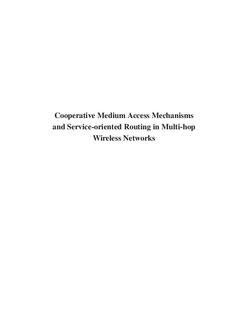| dc.description.abstract | Multi-hop wireless networks have been regarded as a promising path towards future
wireless communication landscape. In the past decade, most related work has been
performed in the context of mobile ad hoc networks. In very recent years, however,
much effort has been shifted to more static networks such as wireless mesh networks
and wireless sensor networks. While significant progress has been achieved through
these years, both theoretically and experimentally, challenges still exist in various
aspects of these networks. For instance, how to use multi-hop networks as a means
for providing broadband Internet services with reliability and balanced load remains
as a challenging task. As the number of end-users is increasing rapidly and more
and more users are enjoying multimedia services, how to provide Quality of Service
(QoS) with user satisfaction in such networks remains also as a hot topic.
Meanwhile, another direction which has recently attracted lots of efforts in the
international research community is the introduction of cooperative communications.
Cooperative communications based on relaying nodes are capable of improving
network performance in terms of increased spectral and power efficiency, extended
network coverage, balanced QoS, infrastructure-less deployment, etc. Cooperation
may happen at different communication layers, at the physical layer where
the received signal is retransmitted and at the MAC and routing layers where a
packet is forwarded to the next hop in a coordinated manner towards the destination,
respectively. However, without joint consideration and design of physical
layer, MAC layer and network layer, the benefit of cooperative communication cannot
be exploited to the maximum extent. In addition, how to extend one-hop cooperative
communication into multi-hop wireless network scenarios remains as an
almost un-chartered research frontier.
In this dissertation, we enhance the state of the art technologies in the field of
multi-hop wireless networks from a layered perspective. While efficient scheduling
mechanisms are proposed at the MAC layer, elaborate routing protocols are devised
at the network layer. More specifically, by taking into account of cross layer design
we cope with network congestion problems in wireless mesh networks mainly at the
network layer. In order to further improve the performance of cooperative wireless
networks, we propose a contention-based cooperative MAC protocol in the presence
of multiple relay nodes. Since a large majority of existing cooperative MAC
protocols are designed based on widely-used IEEE 802.11 MAC protocol which
exhibits inherent design constraint when applied in multi-hop wireless networks, it
is imperative to develop a novel cooperative MAC protocol which is appropriate
for multi-hop network scenarios. Next, we propose a TDMA-based MAC protocol supporting cooperative communications in static multi-hop wireless networks. Furthermore,
a cooperative lifetime maximization MAC protocol is proposed to cope
with the energy hole problem in wireless sensor networks. | no_NO |
